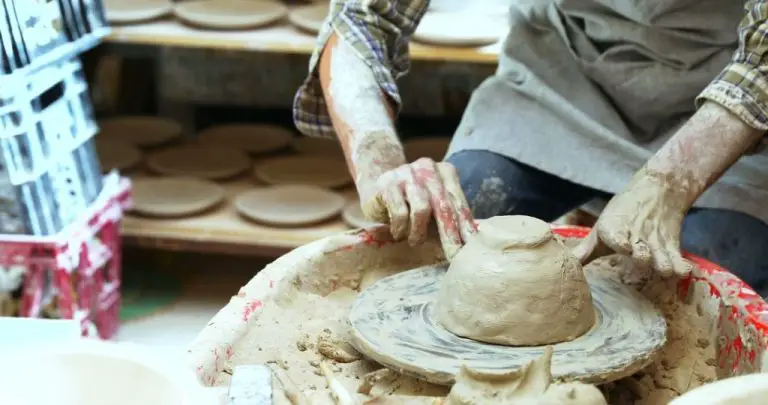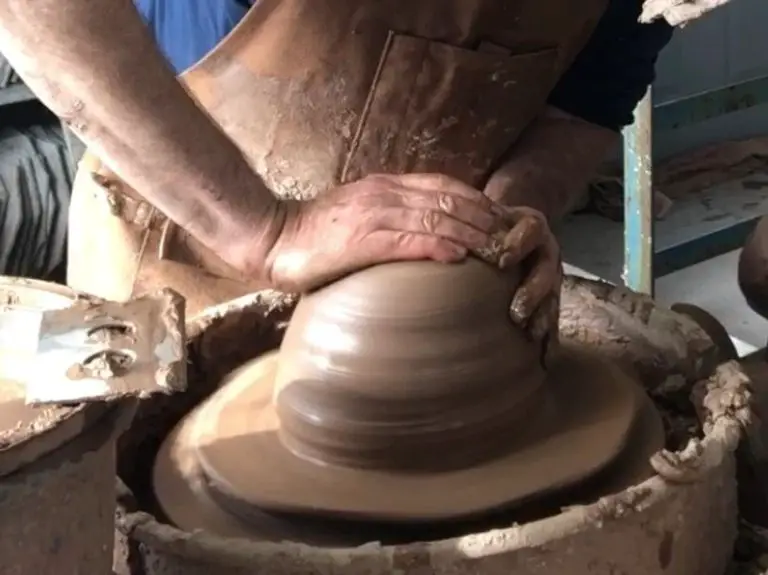How Is Clay Formed For Pottery?
Clay is a naturally occurring material composed primarily of fine-grained minerals, which is plastic when wet. The small particle size of clay minerals and plate-shaped particles allow water to penetrate in between the layers, causing the clay to become moldable and plastic. When clay is fired at high temperatures in a kiln, the clay particles become permanently hard. These properties make clay an ideal material to form ceramic objects like pottery.
Clay has been used to create pottery and ceramic wares for thousands of years across many cultures. The unique characteristics of clay allow it to be shaped into vessels, decoration and art. Clay can be molded into almost any shape while wet, maintains its form when dried, and becomes permanently hard after firing. Creating pottery from clay is an ancient craft that continues to thrive today.
Clay Formation
Clay is formed from the gradual chemical weathering and decomposition of rocks over long periods of time. The minerals that make up clay particles are broken down from larger rock particles and transported in water. As the water flows and slows, the clay particles settle out and accumulate in deposits.
The two main rock types that form clay are feldspar and mica. Feldspar is the most abundant group of minerals in the earth’s crust and breaks down into clay minerals like kaolinite and illite. Mica, especially biotite mica, weathers into clay minerals like vermiculite and montmorillonite.
The chemical weathering process usually happens over thousands or millions of years. Factors like climate, topography, and drainage impact the rate of weathering. In warm, moist environments with good drainage, more chemical weathering takes place compared to dry or cold climates. The weathered particles are transported by water, wind, glaciers, gravity, or a combination of these forces.
Clay deposits accumulate in marine, alluvial, lacustrine, glacial, residual, or eolian environments. The different conditions create clays with unique properties based on mineralogy and particle size. Once deposited, the clay may continue to transform over time through diagenesis, forming sedimentary rock.
Clay Composition
Clay is composed of tiny, sheet-like particles of various aluminum phyllosilicates or other minerals. The chemical composition can vary based on the source of the clay, but the main components are silica, alumina, and water.
The basic building blocks of clay are phyllosilicates, layered minerals made of tetrahedral sheets of silica (SiO4) and octahedral sheets of alumina (AlO6). The way these sheets are stacked determines the structure and properties of the clay mineral. Common clay minerals include kaolinite, montmorillonite, illite, and chlorite.
In addition to the crystalline clay minerals, clay contains other materials like quartz, feldspar, carbonates, oxides, and organic matter. The relative proportions of the minerals determine the plasticity, firing characteristics, and potential uses for the clay body.
Types of Clay
There are several major categories and types of clay used in pottery and ceramics. The main types include:
Earthenware Clays – Earthenware clays contain lower levels of fluxes than stoneware clays and fire at lower temperatures, between 1,750°F and 2,100°F. They tend to be porous and permeable to water. Common types of earthenware clays include terracotta, red earthenware, buff earthenware, and white earthenware.
Stoneware Clays – Stoneware clays contain higher levels of fluxes and can withstand firing at higher temperatures, between 2,100°F to 2,300°F. They are less porous than earthenware clays. Types include porcelain, fine stoneware, and free-stoneware.
Ball Clays – Ball clays are secondary clay minerals and have high plasticity and high dry strength. They are important for producing good throwing clays. Common types are Kentucky Ball Clay and English China Clay.
Fire Clays – Fire clays can withstand very high firing temperatures beyond 2,300°F without deforming. Their uses include insulating kiln shelves and making ceramic fiber. Types include flint clay and plastic fire clay.
Kaolin Clays – Kaolin clays contain the clay mineral kaolinite and have low plasticity. They are often used for porcelain and whiteware products. Types include China clay, ball clay, and kaolin residues.
Clay Preparation
Before clay can be used for pottery, it often requires some preparation and refining to improve its plasticity and workability. Here are some of the main steps involved:
Wedging
Wedging involves repeatedly cutting, folding, and pressing the clay to thoroughly mix it and remove air pockets. This helps evenly distribute moisture, improver plasticity, and removes lumps or foreign particles.
Kneading
Kneading clay is similar to wedging but involves vigorously pressing, folding, and stretching the clay. This further blends the clay particles for a smooth, elastic consistency.
Slaking
Slaking means soaking dry clay in water to rehydrate and disperse clay particles. This allows the clay to fully absorb moisture and become workable again.
Sieving
Pushing clay through a screen or sieve removes rocks, debris, and any hardened lumps. This filters the clay into a uniform, smooth texture ready for throwing or handbuilding.
Proper clay preparation helps remove flaws, improves plasticity and workability, and provides an even consistency ideal for pottery making. The specific techniques used depend on the clay’s initial condition and the type of ware being produced.
Wedging Clay
Wedging is an important step in preparing clay for pottery making. It is the process of cutting and kneading the clay to achieve an even consistency and remove air pockets.
To wedge clay, start with a lump and cut it in half with a wire tool. Then slam the two halves together to join them back into one piece. This action forces air bubbles to the surface. Next, cut the lump in half again at a different angle and slam the pieces back together. Repeat this cutting and slamming 5-10 times.
As you wedge, also knead the clay by pushing it down and away from you with the heels of your hands. Occasionally fold the clay over on itself and push forward. This kneading action further eliminates air pockets and blends the clay evenly.
Wedging removes air bubbles that can cause cracks or explosions during the firing process. It also ensures the clay has a uniform consistency, with no dry or moist spots. Well wedged clay is smooth, pliable, and ready for throwing on the potter’s wheel or handbuilding.
Taking the time to properly wedge clay results in fewer defects and a sturdier finished piece. It’s a simple but essential step for quality pottery.
Kneading Clay
Kneading is an essential step in preparing clay for pottery. It is the process of working and pressing the clay with your hands to make it more pliable and remove air pockets. When clay is freshly dug from the ground, it contains a lot of air bubbles and inconsistencies. Kneading homogenizes the clay by blending the different particles together into one smooth, uniform mass.
During kneading, the clay is pressed and squeezed repeatedly. This compresses the tiny air bubbles trapped within the clay. As the clay is worked over time, these bubbles are eliminated, leaving behind a flexible, easy to shape clay body ready for throwing or handbuilding. With persistent kneading, any hardened or stubborn chunks in the clay also break down, ensuring an even, lump-free consistency.
Kneading by hand takes some physical effort but yields the best results. The warmth and moisture from hands help bring the clay particles together during the kneading motion. It is important not to over-knead the clay, as this can make it become dry and stiff. Kneading for 5-10 minutes by hand is often sufficient for most clay bodies. The clay is ready for the next steps of production when it is smooth, pliable, and air bubble free after kneading.
Slaking Clay
Slaking is a process used to hydrate and mix clay. It involves adding water to dry clay powder to create a slurry or slip. When clay is mined from the earth, it is dried and crushed into a powder. In this dry form, the clay particles cling together and are difficult to mix with water evenly.
During slaking, the dry clay powder is combined with water in a large tub or tank. Enough water is added to fully saturate the clay particles. The mixture is then agitated through stirring or pumping to create a smooth slurry. This hydrates the clay, allowing the particles to fully separate from each other and disperse evenly throughout the water.
Several factors impact the slaking process. The water must be added gradually to prevent clumping. The tank must also allow enough space for the clay and water to mix thoroughly. The clay slurry is generally agitated for 6 to 24 hours to achieve a fully homogenized slip with no lumps remaining. A chemical dispersant is sometimes added to help separate and distribute the clay particles.
Once slaked, the clay slurry is ready for purification processes like sieving and settling to remove debris and impurities. It can then be used for production processes in pottery and ceramic manufacturing. Slaking rehydrates and prepares the clay for further use by unlocking its plasticity and workability.
Sieving Clay
Sieving is an important step in clay preparation to remove any contaminants or unnecessary particles. Clay straight from the ground contains small pebbles, grit, plant matter, and other debris that can weaken the final ceramic piece or create flaws in the finished surface.
Sieving the clay through a fine mesh screen will catch and remove all of these unwanted materials, leaving behind smooth and consistent clay ready for wedging and throwing. The sieving process also helps achieve an even distribution of particle sizes, which contributes to the clay’s workability.
The mesh sizes used range from window screen size to much finer. For most pottery purposes, an 18-mesh screen is typical, which means 18 holes per linear inch. Finer mesh down to 60-mesh and 80-mesh would be used for porcelain clays where an extremely smooth texture is desired. The sieved clay is then ready to be wedged or pugged before throwing and forming pottery pieces.
Proper sieving is a quick but important step that removes impurities and leads to higher quality clay with better consistency for the potter. Starting with clean, sieved clay makes the entire pottery process easier and helps achieve smooth surfaced and flawless fired wares.
Conclusion
The process of clay formation is an important first step in creating high quality pottery. The composition and type of clay determines its suitability for different pottery techniques. Once an appropriate clay is selected, proper preparation through wedging, kneading, slaking, and sieving removes air pockets and creates an even consistency optimal for throwing and handbuilding. Careful clay preparation leads to fewer flaws and cracking when pieces are dried and fired in a kiln.
Understanding how clay is formed geologically provides critical insight into choosing the right clay type for desired results. Some clays with high plasticity are ideal for throwing on the wheel, while others with more coarse particles work better for handbuilding. Testing different locally sourced clays to compare their properties helps potters select materials tailored to their artistic vision.
While the step of clay preparation is often overlooked by beginners, taking the time to properly wedge, knead, slake, and sieve clay results in higher quality finished pieces. Well-prepared clay with minimal air pockets throws more evenly on the wheel and reduces flaws like cracking and breaking. Mastering clay preparation unlocks a potter’s full potential for creating their imaginative visions in clay.



